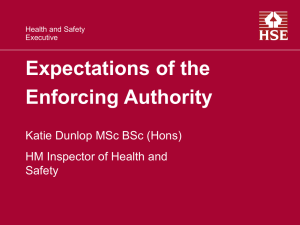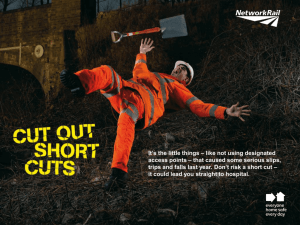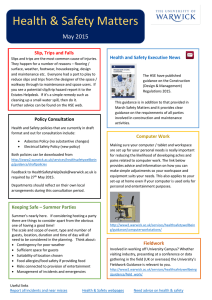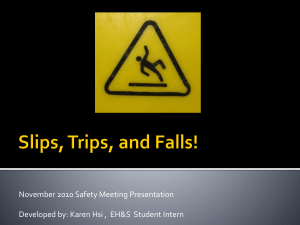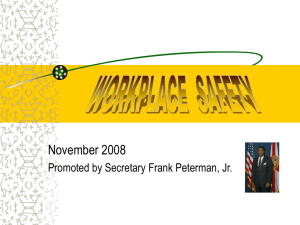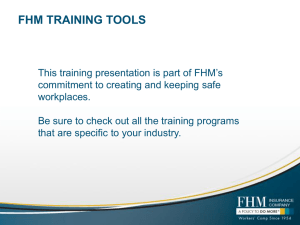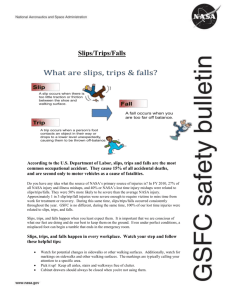Preventing slips and trips at work What is this leaflet about?
advertisement
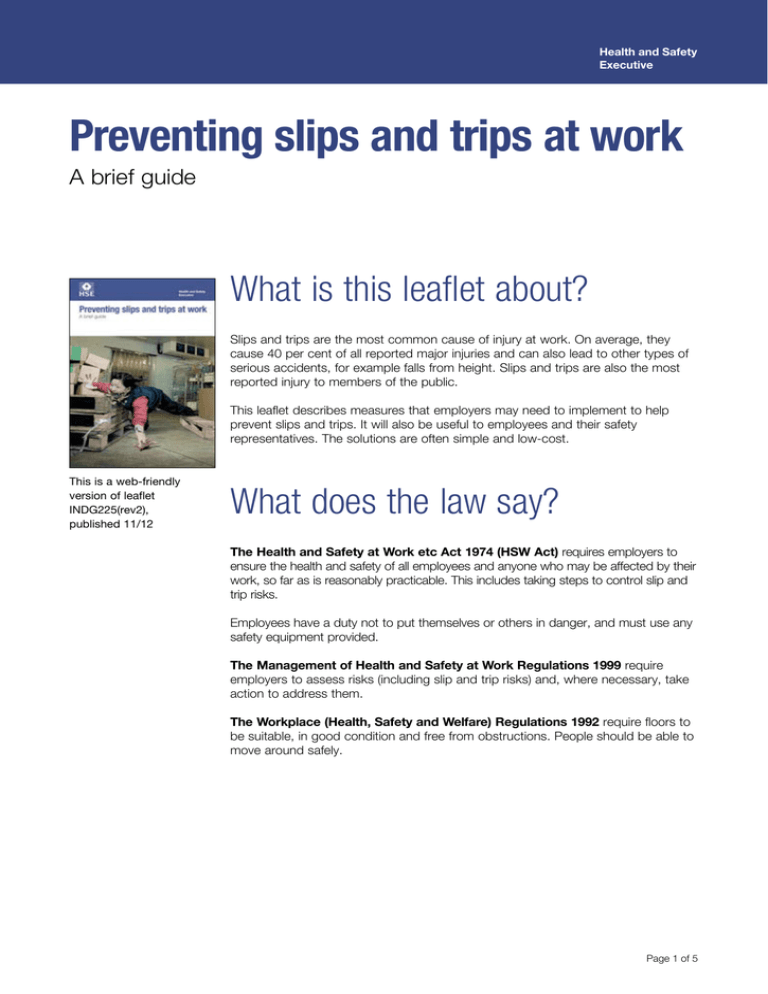
Health and Safety Executive Preventing slips and trips at work A brief guide What is this leaflet about? Slips and trips are the most common cause of injury at work. On average, they cause 40 per cent of all reported major injuries and can also lead to other types of serious accidents, for example falls from height. Slips and trips are also the most reported injury to members of the public. This leaflet describes measures that employers may need to implement to help prevent slips and trips. It will also be useful to employees and their safety representatives. The solutions are often simple and low-cost. This is a web-friendly version of leaflet INDG225(rev2), published 11/12 What does the law say? The Health and Safety at Work etc Act 1974 (HSW Act) requires employers to ensure the health and safety of all employees and anyone who may be affected by their work, so far as is reasonably practicable. This includes taking steps to control slip and trip risks. Employees have a duty not to put themselves or others in danger, and must use any safety equipment provided. The Management of Health and Safety at Work Regulations 1999 require employers to assess risks (including slip and trip risks) and, where necessary, take action to address them. The Workplace (Health, Safety and Welfare) Regulations 1992 require floors to be suitable, in good condition and free from obstructions. People should be able to move around safely. Page 1 of 5 Health and Safety Executive What can employers do to prevent slips and trips? Risk assessment You must manage the health and safety risks in your workplace. To do this you need to decide whether you are doing enough to prevent harm. This process is known as a risk assessment and it is something you are required by law to carry out. A risk assessment is not about creating huge amounts of paperwork, but rather about taking sensible measures to control the risks in your workplace, for example using doormats to stop rainwater being tracked in and making the floor slippery. You are probably already taking steps to protect your employees, but your risk assessment will tell you whether you should be doing more. Consider what risks in your workplace may lead to slip or trip injuries, and decide what suitable and effective control measures will prevent these types of accidents. You then need to put these control measures into practice. Concentrate on the real risks – those that are most likely to cause harm. Think about how accidents could happen and who might be harmed. You can do this by: ■■ asking your employees what they think the hazards are, as they may notice ■■ ■■ things that are not obvious to you and may have some good ideas on how to control the risks; using the hazard-spotting checklist and slips and trips mapping tool to help you identify problem areas (see ‘Find out more’ at the end of the leaflet); referring to the ‘Practical steps to prevent slips and trips accidents’ section below. In many instances, straightforward measures can readily control risks, for example ensuring spillages are cleaned up promptly so people do not slip. Make a record of your significant findings and what you have in place to prevent them. If you have fewer than five employees you don’t have to write anything down but it is good practice to keep a record. Few workplaces stay the same, so it makes sense to review what you are doing on an ongoing basis. More guidance on risk assessment can be found at www.hse.gov.uk/risk. Managing for health and safety A good management system will help you identify problem areas, decide what to do, act on decisions made and check that the steps taken have been effective. Guidance on managing health and safety can be found at www.hse.gov.uk/managing/. Preventing slips and trips at work: A brief guide Page 2 of 5 Health and Safety Executive Practical steps to prevent slips and trips accidents There are many simple ways to control slips and trips risks and prevent accidents in your workplace. Here are a few examples. Stop floors becoming contaminated ■■ ■■ ■■ ■■ ■■ Use entrance matting. Fix leaks from machinery or buildings. Make sure plant and equipment are maintained. Design tasks to minimise spillages. Plan pedestrian and vehicle routes to avoid contaminated areas. Use the right cleaning methods ■■ ■■ ■■ ■■ ■■ ■■ Make sure that your cleaning method is effective for the type of floor you have. Don’t introduce more slip or trip risks while cleaning is being done. Leave smooth floors dry after cleaning or exclude pedestrians until the floor is dry. Remove spillages promptly. Have effective arrangements for both routine cleaning and dealing with spills. Use the appropriate detergent mixed at the correct concentration. Consider the flooring and work environment ■■ Check for loose, damaged and worn flooring and replace as needed. ■■ Floors likely to get wet or have spillages on them should be of a type that does not ■■ ■■ become unduly slippery. Make sure lighting is sufficient and that slopes or steps are clearly visible. Keep walkways and work areas clear of obstructions. Get the right footwear ■■ Where floors cannot be kept clean and dry, slip-resistant footwear can help ■■ ■■ prevent slip accidents. Trial footwear first to make sure it is suitable for the environment and for those who will be wearing it, ie comfort and fit. If footwear is supplied as personal protective equipment (PPE), it must be supplied free of charge to employees. Think about people and organisational factors ■■ Consider how work is organised and managed, eg to avoid rushing, ■■ overcrowding, trailing cables. Make sure employees are involved in the decisions that affect them, eg choice of PPE footwear or a change in cleaning methods. Preventing slips and trips at work: A brief guide Page 3 of 5 Health and Safety Executive What can employees do to prevent slips and trips? In all workplaces: ■■ If you have an accident or a near miss, make sure you report it to your employer ■■ ■■ ■■ ■■ ■■ ■■ promptly. They can use this information to prevent future accidents. If you see a spillage, clean it up or make arrangements for it to be cleaned. Report any damaged floors or mats. Play your part and keep the workplace tidy. If you see items on the floor where someone could trip over them, remove them or arrange for them to be removed or for the situation to be made safe. If you are given PPE, wear it and look after it. Report any faults or damage to your employer and make arrangements for a replacement. Tell your employer about any work situation that you think is dangerous, or if you notice that something has gone wrong with their health and safety arrangements. Find out more HSE has a free online learning tool, called the Slips and Trips eLearning Package, referred to as ‘STEP’ (www.hse.gov.uk/slips/step/start.htm). This tool is designed for both employers and workers in all sectors, providing help on assessing and managing slip and trip risks in the workplace. It provides an overview of slips and trips, how they are caused and how to prevent them, from introductory to advanced level. The hazard spotting checklist is suitable for all workplaces as a practical guide to help employers identify problem areas for slips and trips and how to tackle them: www.hse.gov.uk/pubns/ck4.pdf The slips and trips mapping tool shows you how to identify hotspots for slips and trips in your workplace so that you can prioritise actions: www.hse.gov.uk/slips/mappingtool.pdf An HSE Catering Information Sheet Preventing slips and trips in kitchens and food service (CAIS6) gives more detailed advice for employers in these sectors: www.hse.gov.uk/pubns/cais6.pdf More information about managing slips and trips risks – including flooring, cleaning and footwear – is available on HSE’s website: www.hse.gov.uk/slips/ Preventing slips and trips at work: A brief guide Page 4 of 5 Health and Safety Executive Further information For information about health and safety, or to report inconsistencies or inaccuracies in this guidance, visit www.hse.gov.uk/. You can view HSE guidance online and order priced publications from the website. HSE priced publications are also available from bookshops. This guidance is issued by the Health and Safety Executive. Following the guidance is not compulsory, unless specifically stated, and you are free to take other action. But if you do follow the guidance you will normally be doing enough to comply with the law. Health and safety inspectors seek to secure compliance with the law and may refer to this guidance. This leaflet is available at www.hse.gov.uk/pubns/indg225.htm. © Crown copyright If you wish to reuse this information visit www.hse.gov.uk/copyright.htm for details. First published 11/12. Published by the Health and Safety Executive 02/14 INDG225(rev2) Page 5 of 5
